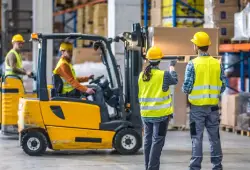Modern EOT Crane Safety: Analytics & Training for New Tech

Forklift Safety Training: Highlighting Common Hazards
August 8, 2024
Adapting Industry Safety Protocols for Modern Resilience
August 10, 2024In the rapidly advancing landscape of industrial operations, the focus on safety is more crucial than ever. Electric Overhead Traveling (EOT) cranes play a pivotal role in various sectors, including manufacturing, logistics, and construction. Given their significance, ensuring that these machines are operated safely is essential. As technology evolves, so do the safety challenges and the corresponding training programs. The incorporation of modern analytics and advanced training methodologies is revolutionizing the way safety is managed for EOT cranes, enhancing both effectiveness and efficiency.
The Evolution of EOT Crane Technology
EOT cranes have been a staple in industrial operations for decades. However, the technology that powers these machines has seen significant advancements in recent years. Modern EOT cranes are now equipped with sophisticated control systems, automation, and monitoring capabilities that were unimaginable just a few years ago. These advancements have made cranes more efficient and capable of handling complex tasks with greater precision.
However, with these technological improvements come new challenges. Operators now need to be trained not just in the basic operation of the cranes, but also in understanding and managing the advanced systems that control them. This shift in technology necessitates an evolution in safety training programs, ensuring that operators are well-equipped to handle the complexities of modern EOT cranes.
Adapting Safety Training for Modern Equipment
Traditional safety training programs for EOT cranes often focused on the mechanical aspects of the equipment—how to operate the crane, how to perform basic maintenance, and how to recognize signs of wear and tear. While these elements remain important, they are no longer sufficient on their own. Modern cranes require a more comprehensive approach to training that includes an understanding of the digital systems and analytics that now play a crucial role in their operation.
One of the key elements in modern EOT crane safety training is the use of analytics. By leveraging data from crane operations, companies can identify patterns and potential risks before they lead to accidents. For example, data on crane usage can reveal trends that might indicate a need for additional training or maintenance. This proactive approach not only improves safety but also enhances the overall efficiency of operations.
Leveraging Analytics for Enhanced Training Programs
Analytics plays a crucial role in the development of modern safety training programs for EOT cranes. By analyzing data from crane operations, companies can gain insights into how cranes are used, where potential risks lie, and what training needs to be emphasized. This data-driven approach allows for the creation of customized training programs that address the specific needs of operators and the particular challenges of their working environment.
For instance, if data shows that a particular crane is frequently used in conditions that increase the risk of accidents, the training program can be adjusted to emphasize safety measures relevant to those conditions. Similarly, if analytics reveal that certain operators are consistently performing better or worse than their peers, targeted training can be provided to help improve performance and safety.
Moreover, analytics can also be used to monitor the effectiveness of training programs. By tracking safety incidents, near-misses, and other relevant metrics, companies can assess whether their training efforts are having the desired impact and make adjustments as needed.
Incorporating Process Safety Management
Process Safety Management (PSM) is another critical component of modern EOT crane safety. PSM involves the systematic identification, evaluation, and control of hazards associated with industrial processes. When applied to EOT crane operations, PSM ensures that all potential risks are accounted for and that appropriate safety measures are in place.
The integration of PSM into crane safety programs helps to create a more holistic approach to safety. By considering not just the mechanical and operational aspects of crane use, but also the broader industrial processes in which cranes are involved, companies can better protect their workers and assets.
The Role of Fire Audits and Fire Risk Assessments
Fire safety is another area where modern EOT crane training programs are evolving. With the increasing complexity of industrial operations, the risk of fire incidents is also on the rise. Fire audits and Fire Risk Assessments are essential tools in identifying potential fire hazards and implementing measures to mitigate these risks.
Incorporating fire safety training into EOT crane programs ensures that operators are aware of the fire risks associated with their work and are prepared to respond appropriately in case of an emergency. This training includes not only the basics of fire prevention and response but also the specific fire risks related to crane operations, such as electrical fires or fires caused by mechanical failures.
Process Safety Management Training
To ensure that all safety measures are effectively implemented, ongoing Process Safety Management Training is essential. This training ensures that all personnel involved in crane operations are up to date on the latest safety protocols and best practices. PSM training also helps to foster a culture of safety within the organization, encouraging workers to prioritize safety in all aspects of their work.
Conclusion
As EOT crane technology continues to evolve, so too must the safety protocols and training programs associated with their use. By integrating modern analytics, Process Safety Management, and fire safety measures into these programs, companies can significantly enhance the safety and efficiency of their operations. The future of EOT crane safety lies in this data-driven, comprehensive approach, ensuring that workers are well-equipped to handle the challenges of modern industrial environments.
By adopting these advanced training methodologies and leveraging the power of analytics, organizations can not only improve safety outcomes but also drive greater operational efficiency, ultimately leading to safer and more productive workplaces.

